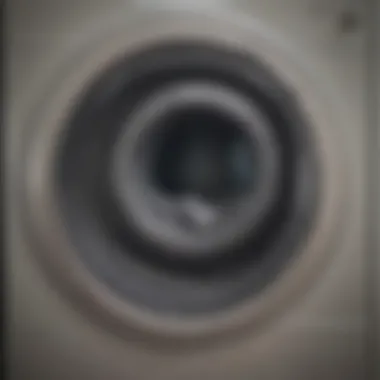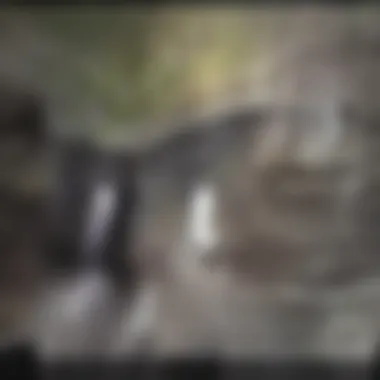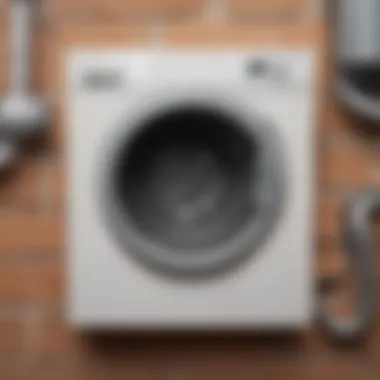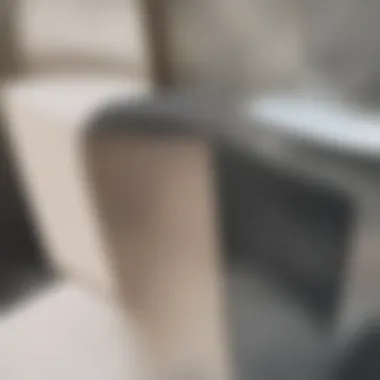Understanding the Dryer Vent Lint Snake: A Comprehensive Insight


Intro
In every home, dryer vents are often an overlooked aspect of appliance maintenance, yet their importance cannot be stressed enough. A crucial tool in maintaining these vents is the dryer vent lint snake. This article serves as an extensive guide, providing insights into lint buildup, potential hazards, and how to use specialized tools effectively to ensure safety and efficiency.
Having an understanding of dryer vent lint snakes can facilitate homeowners in maintaining their appliances, ultimately preventing disaster. Information on how to properly remove lint and the role of a lint snake in this process is vital. Owners should be aware that neglecting dryer vents can lead to inefficiency and fire hazards, which are serious concerns.
Feature Spotlight
The dryer vent lint snake is designed specifically for accessing hard-to-reach areas in a dryer vent system. Its design can vary, but several standout features generally enhance its efficacy:
- Flexible Structure: The lint snake's design allows it to navigate through bends and turns in the ductwork, enabling effective cleaning in tight spaces.
- Extended Reach: Many lint snakes come with adjustable lengths, giving homeowners the ability to reach deep into their vents that might be otherwise inaccessible.
- Durable Materials: Constructed from high-quality materials, these tools endure frequent use while maintaining their performance. They offer longevity and reliability.
Importance of Regular Maintenance
Regularly cleaning your dryer vent is essential. Consider the following points about lint buildup and maintenance:
- Fire Hazard: Lint is highly flammable. A clogged vent can trap heat and ignite a fire, posing a threat to your home.
- Decreased Efficiency: A dryer with a blocked vent takes longer to dry clothes, increasing energy bills and wearing out the machine more quickly.
- Health Implications: Inadequate airflow can lead to moisture buildup, fostering mold and mildew, which can harm your air quality.
Using a lint snake not only mitigates these risks but also enhances dryer performance.
"Regular maintenance of dryer vents prevents buildup that not only saves time and energy but also ensures safety at home."
Epilogue
Understanding the functionality of a dryer vent lint snake and the importance of regular maintenance can lead to safer and more efficient dryer use. Homeowners should prioritize these practices to maintain the longevity of their appliances and reduce potential dangers.
Prelims to Dryer Vent Lint
Understanding dryer vent lint is crucial for homeowners seeking to maintain their appliances efficiently and safely. Lint buildup can lead to various issues, including reduced dryer performance and increased risk of fire hazards. This section aims to provide an in-depth overview of what dryer vent lint is, its sources, and why it matters.
Definition of Dryer Vent Lint
Dryer vent lint refers to the accumulation of small fibers, dust, and debris that are released from clothing during the drying process. These particles collect in the dryer vent system, obstructing airflow. This buildup can occur in all types of dryers, whether they are gas or electric. It is important to differentiate between lint that gathers in the lint trap and lint that accumulates in the vent itself. While the lint trap captures a significant amount of fluff, not all lint can be contained within it.
Common Sources of Lint
Lint primarily originates from the clothes being dried. Every time garments—especially those made of cotton, polyester, or other synthetic materials—are placed in the dryer, some fibers detach and become airborne. Here are common sources of lint:
- Fabric Composition: Natural fibers like cotton shed more lint compared to synthetic fabrics.
- Wear and Tear: Older garments tend to release more lint due to weakened fibers.
- Washing Process: When clothes are washed, detergent and agitation can loosen fibers, adding to the lint produced.
- Dryer Conditions: Frequent drying of heavy items like towels can increase lint production due to their abrasive nature.
Regular understanding of these sources can help homeowners take precuations against excessive lint buildup in the dryer vent.
The Mechanics of Dryer Vents
The mechanics of dryer vents play a crucial role in ensuring the smooth operation of laundry appliances. Understanding how dryer vents operate can help homeowners recognize their importance in maintaining optimal dryer efficiency and safety. Proper functionality is central to preventing issues like lint buildup, which can lead to severe consequences.
How Dryer Vents Function
Dryer vents serve as the pathways through which hot, moist air and lint exit the dryer. When the dryer operates, it heats up the air to dry clothes. This air carries moisture from the clothes as well as lint produced during the drying process. The dryer uses a fan to push this combination through the vent system, where it travels to the exterior of the home.
The vent works through a series of components:


- Exhaust Fan: Facilitates the expulsion of hot air.
- Ducts: Channels the air to an external vent; duct material affects performance and fire safety.
- Exterior Vent Cover: Prevents backdrafts and pests from entering the venting system.
Over time, lint can accumulate in the ducts, especially if they are not cleaned regularly. This buildup impairs airflow and forces the dryer to work harder to expel the air. Consequently, this can result in increased drying times and higher energy costs.
Types of Dryer Vent Systems
There are various types of dryer vent systems, each serving the same essential purpose with slight variations in design and function:
- Rigid Metal Ducts: These ducts are usually made from aluminum or galvanized steel. They are recommended for their durability and lower chances of lint accumulation.
- Flexible Metal Ducts: Easier to install compared to rigid ducts but can be prone to kinks that trap lint. It's essential to use high-quality materials that meet safety standards.
- Vinyl or Plastic Ducts: These were once common but are now discouraged. They are flammable and not as effective in preventing lint buildup.
- Semi-Rigid Ducts: Provide a balance between flexibility and strength but can still trap lint if not properly maintained.
Each type comes with its own set of benefits and drawbacks. When choosing a dryer vent system, consider the ease of installation, fire safety, and the likelihood of lint accumulation. It is strongly recommended to follow the manufacturer's guidelines for installation to ensure safety and efficiency.
Regular maintenance of dryer vents is essential to prevent dangerous lint buildup, which can pose a fire risk and decrease dryer efficiency.
Epilogue
Understanding the mechanics of dryer vents is fundamental for every homeowner. Proper functioning dryer vents not only enhance dryer efficiency but also reduce risks associated with lint accumulation. Knowing how these systems work can aid in making informed decisions about maintenance and upgrades to better protect one's home.
Lint Buildup: Causes and Consequences
Understanding the buildup of lint in dryer vents is essential for maintaining home safety and appliance efficiency. Over time, lint accumulation can lead to a range of issues, from decreased dryer performance to significant fire hazards. In essence, recognizing the causes of lint buildup can help homeowners implement preventive strategies while being aware of the potential consequences of ignoring these issues.
Common Causes of Lint Accumulation
Lint accumulation occurs due to several factors, each contributing to the inability of the dryer vent system to expel air effectively.
- Insufficient Ventilation: If the dryer vent is too long or has multiple bends, airflow is restricted, causing lint to accumulate. Long runs of duct create a greater space for lint to settle.
- Blocked Vents: Objects such as bird nests, debris, or even kinks in the vent can hinder airflow, creating an environment where lint can build up over time.
- Dryer Type: Different dryers can produce varying amounts of lint. For instance, older models may not filter lint as efficiently as newer ones, leading to excessive buildup.
- Fabric Type: Certain materials release more lint than others. Fluffy materials, like towels and fleece, contribute significantly to lint generation. Frequent drying of these items adds to the problem.
- Usage Habits: Overloading the dryer can lead to lint accumulation. When the dryer is overly stuffed, items don't separate and tumble as they should, resulting in more lint being released into the vent.
By understanding these causes, homeowners can take appropriate actions to prevent excessive lint buildup in their dryer vents.
Dangers of Ignored Lint Issues
Neglecting lint issues in dryer vents can have severe repercussions. The dangers include:
- Fire Hazards: Lint is highly flammable. When it accumulates in a dryer vent, it can ignite, leading to dangerous fires that not only endanger lives but can also result in significant property damage. According to the National Fire Protection Association, failure to clean dryer vents is a leading cause of home dryer fires.
- Reduced Efficiency: Lint buildup can force the dryer to work harder to push air through, leading to increased energy consumption. This can result in higher utility bills and increased wear and tear on the appliance, shortening its lifespan.
- Damage to the Dryer: Over time, excessive lint buildup can lead to malfunctioning of the dryer’s internal components. This may result in costly repairs or even the need for a full replacement.
- Humidity Issues: Clogged vents can trap moisture, creating an environment conducive to mold and mildew growth. This not only affects the quality of laundered items but can also lead to health concerns for inhabitants.
Ignoring dryer vent lint issues is not just a matter of appliance maintenance; it directly impacts your home’s safety.
Awareness of these dangers can motivate homeowners to adopt preventive measures and ensure that their dryer vents remain clear and functional. Regular cleaning and the use of tools like dryer vent lint snakes can mitigate these risks, ensuring safety and efficiency in laundry appliance operations.
The Role of the Dryer Vent Lint Snake
Understanding the role of the dryer vent lint snake is essential for maintaining both the efficiency of your dryer and household safety. As laundry appliances become a daily necessity, the need for effective lint removal methods increases. This is where the lint snake proves its remarkable value. Primarily designed to reach deep into dryer vents, this long, flexible tool helps remove stubborn lint buildup that otherwise remains out of reach.
What is a Dryer Vent Lint Snake?
A dryer vent lint snake is a specialized tool crafted to clear away lint and debris from the dryer vent system. Generally, it consists of a long, thin, and flexible body often made of nylon bristles attached to a sturdy yet flexible pole. The design allows it to navigate curves and corners within the vent, where traditional cleaning methods fail. This tool can vary in length, but the average option is around 12 to 30 feet to adequately cover most residential vent lengths.
The lint snake's primary objective is to mitigate lint buildup, which can cause various functional problems with the dryer. Regular cleaning with it helps in ensuring optimal airflow to the dryer, which directly correlates to drying efficiency. It assists homeowners in achieving a thorough clean without the need for professional help, making it a practical solution for many.
How a Lint Snake Works


Using a lint snake effectively is straightforward yet involves a few essential steps. Initially, one should prepare by disconnecting the dryer from the power source, ensuring safety. Once the dryer is off, insert the lint snake into the vent from both the dryer side and the exit point. The flexibility of the snake allows it to easily maneuver past turns and elbows in the ductwork.
As the owner pushes the snake further into the vent system, the bristles on the tool grab and pull out accumulated lint. This process may need to be repeated multiple times to fully clear the vent, especially if there is considerable buildup.
Thus, the dryer vent lint snake serves an important function in regular dryer maintenance. Its capability to reach hidden lint spots enhances dryer efficiency, cuts down on energy costs, and minimizes the risk of fire hazards associated with neglected dryer vents.
Regular use of a lint snake can greatly reduce the risk of fires, improving the overall safety of your home.
In summary, recognizing the significance of the dryer vent lint snake helps homeowners appreciate its vital role in preserving dryer function and household safety.
Benefits of Using a Dryer Vent Lint Snake
Using a dryer vent lint snake presents several advantages that homeowners should not underestimate. Lint buildup in dryer vents can significantly impede the efficiency of dryer operations, potentially leading to hazardous situations. The role of a lint snake in addressing these issues is essential for maintaining a safe and functional laundry environment.
Improved Dryer Efficiency
One of the primary benefits of utilizing a dryer vent lint snake is improved dryer efficiency. When lint accumulates in the vent, it restricts airflow, which forces the dryer to work harder. This increased strain not only extends drying times but can also lead to overheating. When you use a lint snake, it helps to remove stubborn lint deposits that have built up over time. As a result, airflow is restored.
This improvement in airflow ensures that laundry dries more quickly, making laundry days less tedious.
Households can notice a decrease in energy bills as dryers begin to operate more efficiently. Better airflow can also prolong the life of the dryer, reducing overall maintenance needs.
Enhanced Safety
Lint buildup is not just a matter of inconvenience; it poses a real safety risk. In fact, clogged dryer vents are a leading cause of household fires.
Using a lint snake regularly decreases the amount of lint accumulating in the vent, lowering the chance of lint catching fire.
When homeowners address lint buildup proactively, they create a safer environment for their families.
Even small amounts of retained heat can contribute to fire hazards. Therefore, using a lint snake not only cleans out the vent but also gives homeowners peace of mind, knowing that they are lessening potential dangers.
Cost-effectiveness in Maintenance
Engaging in regular maintenance with a dryer vent lint snake is also a cost-effective choice. While many might consider calling in professionals for maintenance, the lint snake presents an alternative.
Investing in a lint snake is a one-time purchase that may save money in the long run.
Many homeowners may not realize how much they can save by performing their upkeep.
Not only does this reduce the frequency of expensive professional cleanings, but it also prolongs the lifespan of the dryer.
With less wear and tear, homeowners can avoid unnecessary replacements.
By adopting a simple routine with the lint snake, both efficiency and safety are enhanced, while costs are kept down.
How to Use a Dryer Vent Lint Snake
Understanding the correct use of a dryer vent lint snake is vital for maintaining your dryer’s efficiency and safety. A lint snake can effectively remove lint buildup that creates various problems, including reduced airflow, longer drying times, and increased fire risks. Knowing how to use this tool properly allows homeowners to maintain their dryer ventilation system without needing to hire professionals frequently.
Preparation and Tools Needed
Before you start using a dryer vent lint snake, you need to gather some essential tools and prepare your workspace. The following items are necessary:
- Dryer Vent Lint Snake: This specialized tool usually features a long, flexible rod with bristles. It reaches into the vent to remove lint.
- Vacuum Cleaner: A standard vacuum helps to collect loosened lint and debris
- Screwdriver: This may be needed to detach the vent from the dryer depending on your setup.
- Safety Goggles: Protect your eyes from dust and debris when cleaning.
- Dust Mask: Wearing a mask helps avoid inhaling any dust particles.
Preparation steps are simple. First, unplug your dryer for safety. Next, move the dryer away from the wall to access the vent. If necessary, use the screwdriver to disconnect the vent from the dryer. Ensure your environment is clean and well-lit.
Cleaning Procedure Step-by-Step
Once you've gathered the tools and prepared your workspace, follow these steps to effectively use the dryer vent lint snake:
- Insert the Lint Snake: Gently push the lint snake into the vent opening. Make sure to move slowly to avoid damaging the vent.
- Twist and Turn: As you push the snake forward, twist it to help dislodge any lint accumulation. This motion ensures a thorough cleaning.
- Pull Back Gently: After you’ve reached the end of the vent, slowly pull the snake back out. This motion brings with it any lint and debris that has been loosened.
- Use a Vacuum Cleaner: Follow up with a vacuum cleaner to remove any remaining lint inside the vent and around the dryer.
- Reattach Vent: If you removed the vent, now is the time to reconnect it. Use the screwdriver if necessary.
- Perform Regular Checks: Make it a habit to check the vent periodically. Regular maintenance keeps your dryer running efficiently.
Proper use of a dryer vent lint snake not only prolongs the life of your appliance but also enhances its performance dramatically.
By following these guidelines for using a dryer vent lint snake, you contribute significantly to the longevity and safety of your dryer. This simple tool, when used correctly, can minimize fire hazards and improve the overall efficiency of laundry operations. Always prioritize safety and maintenance to ensure a better experience with your household appliances.
Preventive Measures and Maintenance Tips
Maintaining a dryer vent is crucial for both safety and efficiency. Regular checks and cleaning help to prevent lint buildup, which can lead to fire hazards and reduced drying performance. Taking preventive measures ensures that your dryer operates effectively and lasts longer. Understanding these measures can also save homeowners from extensive repair costs and enhance the safety of their home.


Regular Maintenance Routines
Establishing and adhering to a systematic maintenance routine is essential in avoiding potential issues with your dryer vent. Here are a few steps to include in your routine:
- Monthly Inspections: Check the exterior vent to ensure it opens and closes freely. Also, look for signs of damage or obstruction.
- Cleaning the Lint Screen: Clean the lint filter before and after each use. This simple action can prevent lint from accumulating inside the machine and in the vent.
- Seasonal Deep Cleaning: Every few months, carry out a thorough cleaning using a dryer vent lint snake. This tool is designed to reach the length of your vent and remove lint buildup.
Adopting these preventive measures not only makes your dryer run more efficiently but also extends its lifespan.
Signs You Need to Clean Your Vent
Detecting when your dryer vent requires cleaning is an important aspect of maintenance. Here are some clues to watch for:
- Increased Drying Time: If clothes are taking longer than normal to dry, it suggests lint accumulation is restricting airflow.
- Overheating: If the dryer feels unusually hot to the touch, this can indicate that air is not circulating properly.
- Burning Smell: An unpleasant odor can arise from lint catching fire in extreme cases. This requires immediate attention.
- Visible Lint Outside the Vent: Finding lint accumulated outside the vent or near the dryer is a strong sign that cleaning is needed.
"Neglected dryer vents can contribute to serious fire hazards, making regular maintenance not only a good idea but a necessity."
By being proactive in maintenance and recognizing these warning signs, homeowners can greatly reduce risks associated with dryer vent lint buildup.
DIY vs. Professional Cleaning
The decision between tackling dryer vent cleaning yourself or hiring a professional can greatly impact the efficiency and safety of your appliances. Each approach has its own merits and considerations, which are essential to understand. Engaging in DIY cleaning can be a cost-effective choice but demands a certain level of commitment and knowledge. On the other hand, professionals bring experience and specialized tools that can guarantee thorough cleaning.
Advantages of DIY Cleaning
There are several benefits to opting for DIY dryer vent cleaning. First, you save money by avoiding service fees. Purchasing a dryer vent lint snake and other necessary tools is generally affordable. Individuals can also tailor the cleaning process to their schedule, providing flexibility in home maintenance.
Another advantage is that DIY cleaning fosters a deeper understanding of how your dryer and vent system operate. This hands-on approach enables you to identify problems and address them proactively. Additionally, one can take pride in maintaining their appliances, while also enjoying the immediate rewards of improved dryer efficiency and reduced fire risk.
- Cost Savings: Avoid professional fees.
- Flexible Timing: Clean when it's convenient.
- Knowledge Gained: Understand your system better.
- Satisfaction: Pride in doing it yourself.
When to Seek Professional Help
Despite the benefits of DIY methods, there are situations where professional assistance may be necessary. Complex or severe lint buildup may require specialized equipment that the average homeowner does not possess. Professionals can often handle large accumulations more effectively, reducing the risk of damage to the vent system.
Another scenario involves the need for thorough inspections. Professionals can identify underlying issues that might not be visible to an untrained eye. For instance, if you notice reduced drying efficiency consistently or hear odd noises from your dryer, it’s time to consult an expert.
- Severe Buildup: Heavy lint problems might require professional tools.
- Inspection Needs: Trained eyes catch issues homeowners may miss.
- Persistent Problems: Unusual dryer behavior needs investigation.
Seeking help from professionals can often prevent greater problems down the line, saving time and potential costs in repairs.
Understanding the balance between DIY and professional cleaning is key for maintaining optimal dryer function and safety in your home.
Epilogue
The conclusion of this article underscores the critical nature of understanding dryer vent lint and the role of a dryer vent lint snake in maintaining dryer efficiency and safety. Neglecting dryer vents can lead to a plethora of issues, including potential fire hazards, decreased efficiency of the dryer, and increased energy bills. This article has detailed the mechanics of lint buildup, the dangers associated with it, and the benefits of regular maintenance. By utilizing a lint snake, homeowners can directly address these concerns, ensuring their appliances work optimally and safely.
Recap of Key Points
In this comprehensive overview, we have explored several essential aspects:
- Definition and Sources of Lint: Understanding what dryer vent lint is and where it originates is fundamental.
- Mechanics of Dryer Vents: We examined how dryer vents operate and the various types of vent systems available.
- Causes and Consequences of Lint Buildup: Identifying common reasons for lint accumulation helps in preventing the associated dangers such as fires.
- Functionality of the Lint Snake: A thorough look at how a lint snake works to remove buildup effectively.
- Benefits: The lint snake dramatically improves dryer efficiency and safety, while also being cost-effective in maintenance.
- Usage Guidelines: Detailed steps for both DIY and professional services can guide homeowners in their cleaning efforts.
- Preventive Measures: Knowing signs of lint buildup can reduce the need for more extensive repairs in the future.
Final Thoughts on Dryer Vent Care
In light of all discussed elements, dryer vent care emerges as an important task for homeowners. The real estate aficionados and interior design lovers among us must realize that a well-maintained home extends to every aspect of household management, including appliances. Regular checks and cleaning of dryer vents should be a priority. Utilizing a dryer vent lint snake is both a preventive measure and a maintenance strategy that protects your home from potential disasters.
Being aware of these issues and actively addressing them enhances safety and efficiency. It saves money, reduces energy consumption, and prolongs the lifespan of the dryer. Visiting resources such as Wikipedia or Britannica can offer additional insights into maintaining household appliances.
Investing time in understanding and implementing proper dryer vent care will serve homeowners well in the long run.







